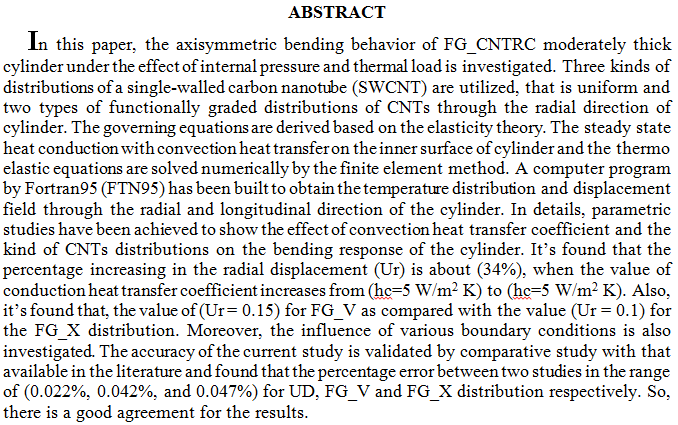
BN Rashid, AKF Jameel, Al- Ustath: Quarterly Scientific Journal, 2017 - Cited by 15
Prostheses are used as an alternative to organs lost from the body. Flex-Foot Cheetah is considered one of the lower limb prostheses used in high-intensity activities such as running. This research focused on testing two samples of Flex-Foot Cheetah manufactured of two various materials (carbon, glass) with polyester and compare between them to find the foot with the best performance in running on the level of professional athlete. In the numerical analysis, the maximum principal stress, maximum principal elastic strain, strain energy; finally, the blade total deformation were calculated for both feet. In experimental work, the load-deflection test was done for foot to calculate the bending the results were very close to
... Show More (14)
(14)
 (36)
(36)
 (36)
(36)
In this research we present An idea of setting up same split plots experiments in many locations and many periods by Latin Square Design. This cases represents a modest contribution in area of design and analysis of experiments. we had written (theoretically) the general plans, the mathematical models for these experiments, and finding the derivations of EMS for each component (source) of sources of variation of the analysis of variance tables which uses for the statistical analysis for these expirements
This study's objective is to assess how well UV spectrophotometry can be used in conjunction with multivariate calibration based on partial least squares (PLS) regression for concurrent quantitative analysis of antibacterial mixture (Levofloxacin (LIV), Metronidazole (MET), Rifampicin (RIF) and Sulfamethoxazole (SUL)) in their artificial mixtures and pharmaceutical formulations. The experimental calibration and validation matrixes were created using 42 and 39 samples, respectively. The concentration range taken into account was 0-17 μg/mL for all components. The calibration standards' absorbance measurements were made between 210 and 350 nm, with intervals of 0.2 nm. The associated parameters were examined in order to develop the optimal c
... Show More (3)
(3)
 (2)
(2)
 (25)
(25)
 (21)
(21)
Reflection cracking in asphalt concrete (AC) overlays is a common form of pavement deterioration that occurs when underlying cracks and joints in the pavement structure propagate through an overlay due to thermal and traffic-induced movement, ultimately degrading the pavement’s lifespan and performance. This study aims to determine how alterations in overlay thickness and temperature conditions, the incorporation of chopped fibers, and the use of geotextiles influence the overlay’s capacity to postpone the occurrence of reflection cracking. To achieve the above objective, a total of 36 prism specimens were prepared and tested using an overlay testing machine (OTM). The variables considered in this study were the thickness of the
... Show More (6)
(6)
 (7)
(7)
Reflection cracking in asphalt concrete (AC) overlays is a common form of pavement deterioration that occurs when underlying cracks and joints in the pavement structure propagate through an overlay due to thermal and traffic-induced movement, ultimately degrading the pavement’s lifespan and performance. This study aims to determine how alterations in overlay thickness and temperature conditions, the incorporation of chopped fibers, and the use of geotextiles influence the overlay’s capacity to postpone the occurrence of reflection cracking. To achieve the above objective, a total of 36 prism specimens were prepared and tested using an overlay testing machine (OTM). The variables considered in this study were the thickness of the
... Show More (6)
(6)
 (7)
(7)
When the flange of a reinforced concrete spandrel beam is in tension, current design codes and specifications enable a portion of the bonded flexure tension reinforcement to be distributed over an effective flange width. The flexural behavior of the RC L-shaped spandrel beam when reinforcement is laterally displaced in the tension flange is investigated experimentally and numerically in this work. Numerical analysis utilizing the finite element method is performed on discretized flanged beam models validated using experimentally verified L-shaped beam specimens to achieve study objectives. A parametric study was carried out to evaluate the influence of various factors on the beam’s flexure behavior. Results showed that
... Show More (3)
(3)
